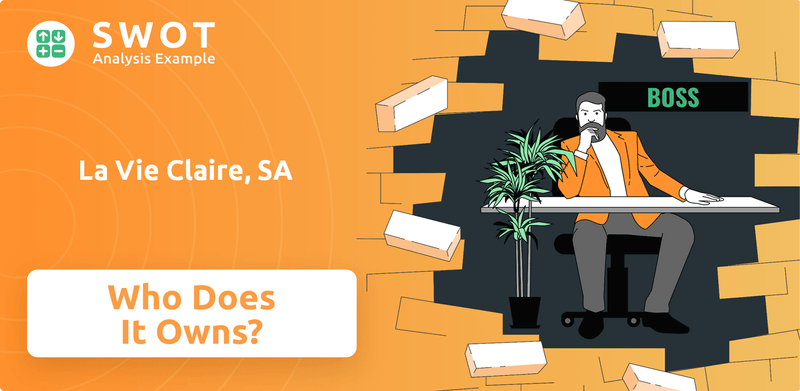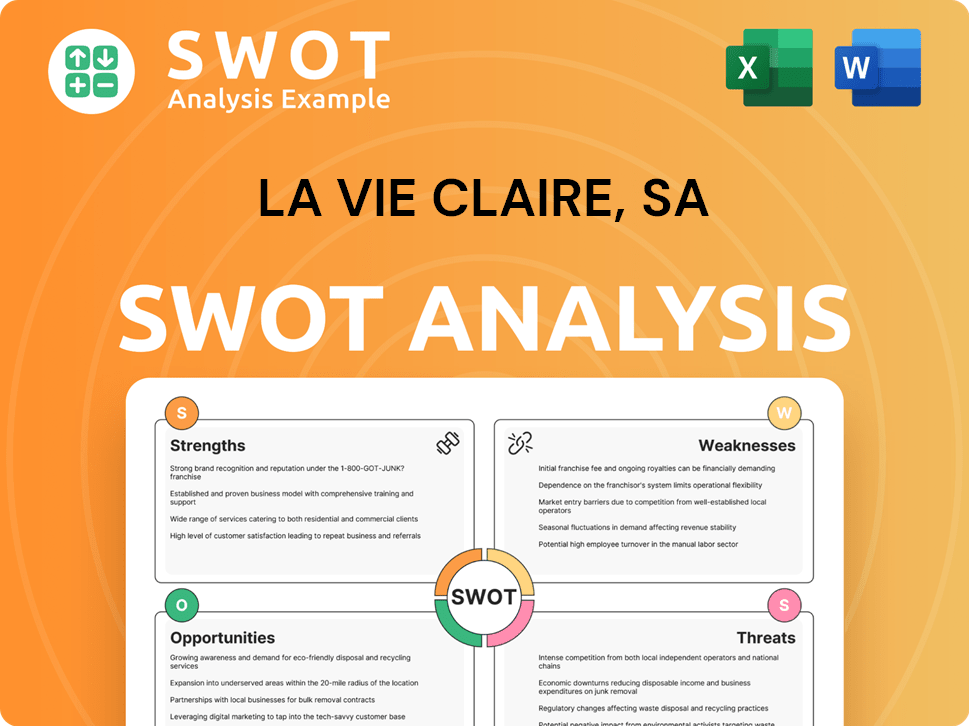La Vie Claire, SA Bundle
Who Really Owns La Vie Claire?
Unravel the ownership secrets of La Vie Claire, a cornerstone of France's organic food market. From its humble beginnings in 1946 as a champion of healthy eating, this brand has blossomed into a retail powerhouse. Discover the key players and pivotal moments that have shaped the La Vie Claire, SA SWOT Analysis and its trajectory in a rapidly evolving industry.

Understanding the La Vie Claire owner and its ownership structure is crucial for anyone interested in the company's future. This exploration of the La Vie Claire company delves into its history, from its founding to its current position with approximately 327 stores in 2025, revealing who controls La Vie Claire. We will examine the major shareholders and how their influence impacts the La Vie Claire brand and its strategic direction.
Who Founded La Vie Claire, SA?
The story of the La Vie Claire company begins with Henri-Charles Geffroy. He launched a newspaper in 1946, sharing his ideas on healthy eating. This initiative paved the way for the first La Vie Claire co-operative, which opened in Paris in March 1948. This cooperative was the starting point for the organic store network we see today.
The co-operative was designed to supply subscribers with the healthy food products that Geffroy promoted. In 1951, the co-operative evolved into 'l'Aliment sain' and later became 'Société française d'alimentation saine' in 1965. The shift from a co-operative to a limited company marked a change in its legal and ownership structure.
Specific details about the initial equity split or shareholding percentages at the company's start under Henri-Charles Geffroy are not publicly available. The early structure as a co-operative suggests a community-focused ownership model. The original backers were primarily readers of Geffroy's magazine, who wanted access to the products he advocated. This vision of promoting a natural and healthy diet has remained a core principle of La Vie Claire.
The initial ownership of La Vie Claire was rooted in a co-operative model, driven by Henri-Charles Geffroy's vision. The transition to a limited company in 1965 marked a significant change in the ownership structure. Understanding the La Vie Claire ownership history provides context to its evolution.
- The co-operative model focused on providing healthy food to members.
- Early backers were primarily readers of Geffroy's magazine.
- The shift to a limited company changed the legal and ownership framework.
- The founding vision centered on promoting a natural and healthy diet.
La Vie Claire, SA SWOT Analysis
- Complete SWOT Breakdown
- Fully Customizable
- Editable in Excel & Word
- Professional Formatting
- Investor-Ready Format

How Has La Vie Claire, SA’s Ownership Changed Over Time?
The journey of La Vie Claire's ownership has seen several pivotal shifts since its inception. Initially, Groupe Bernard Tapie acquired the company in 1980, aiming to modernize and expand its reach. This period even included sponsoring a well-known cycling team. However, challenges arose, leading to its sale by the Consortium de réalisation (CDR) in 1996 after the Bernard Tapie era, to Distriborg, an organic food group under Régis Pelen.
A critical turning point occurred in 2000 when Régis Pelen sold the Distriborg group but retained La Vie Claire through his holding company, Investissement et Développement. This strategic move allowed Pelen to maintain control and focus on revitalizing the brand. Understanding the evolution of La Vie Claire's history helps to understand its current ownership structure.
| Year | Event | Impact on Ownership |
|---|---|---|
| 1980 | Acquisition by Groupe Bernard Tapie | Modernization and expansion efforts began. |
| 1996 | Sale to Distriborg | Transition to Régis Pelen's ownership. |
| 2000 | Régis Pelen retains La Vie Claire | Consolidation of control under Pelen's holding company. |
As of July 2024, the ownership of the La Vie Claire company is predominantly held by the Pelen family, who control a significant 85.47% of the company's capital. Employees and management collectively possess 7.40%, while a corporate endowment fund holds 1.20%. This structure provides stability for strategic direction and long-term planning, enabling the company to navigate market dynamics and maintain its commitment to organic principles. This concentrated ownership highlights who owns La Vie Claire.
The Pelen family's majority stake ensures strategic stability and a long-term vision for La Vie Claire. This structure allows for focused management and the ability to adapt to market changes. Understanding the La Vie Claire ownership structure is key.
- Pelen family holds a significant majority.
- Employees and management have a stake.
- Corporate endowment fund also holds shares.
- Focus on quality and organic principles.
La Vie Claire, SA PESTLE Analysis
- Covers All 6 PESTLE Categories
- No Research Needed – Save Hours of Work
- Built by Experts, Trusted by Consultants
- Instant Download, Ready to Use
- 100% Editable, Fully Customizable

Who Sits on La Vie Claire, SA’s Board?
The governance structure of La Vie Claire, a 'Société anonyme à conseil d'administration' (SA), includes a Board of Directors and a Directoire (Management Board). As of April 2025, Régis Pelen serves as the President of the Supervisory Board, indicating his continued influence. The Directoire, responsible for daily management, is led by Christelle Le Hir, who has been the President of the Directoire since 2022. Other key members include Alexandre Senaffe, Chief Financial, Legal & IT Officer.
The Supervisory Board also includes Bruno Pelen, overseeing the franchised stores network, and Mathilde Pelen-Rastier. Additional members include Hubert Jaricot, Véronique Billaud, Brigitte Bernardette Brunel-Marmone, Didier Merland, Stéphanie Danièle Marie Pascal, Frédéric Jean Jacques Picavet, and Christine Romain. This composition highlights a blend of family influence and strategic oversight within the company. Understanding the target market of La Vie Claire is essential for grasping its strategic direction.
| Role | Name | Title |
|---|---|---|
| President of the Supervisory Board | Régis Pelen | President |
| President of the Directoire | Christelle Le Hir | President |
| Chief Financial, Legal & IT Officer | Alexandre Senaffe | Officer |
| Supervisory Board Member | Bruno Pelen | Member |
| Supervisory Board Member | Mathilde Pelen-Rastier | Member |
The Pelen family's substantial majority ownership of 85.47% of the capital gives them significant control over major decisions. Employees and management hold 7.40%, and the endowment fund holds 1.20%. The concentrated ownership by the Pelen family enables La Vie Claire to maintain its independence and commitment to its core values, rather than being swayed by short-term market pressures.
The Pelen family's significant ownership stake in La Vie Claire gives them substantial control. This structure helps maintain the company's values and independence.
- The Pelen family owns 85.47% of the company.
- Employees and management hold 7.40%.
- The endowment fund holds 1.20%.
- This ownership structure ensures the company's strategic direction.
La Vie Claire, SA Business Model Canvas
- Complete 9-Block Business Model Canvas
- Effortlessly Communicate Your Business Strategy
- Investor-Ready BMC Format
- 100% Editable and Customizable
- Clear and Structured Layout

What Recent Changes Have Shaped La Vie Claire, SA’s Ownership Landscape?
The recent developments at La Vie Claire, the organic food retailer, showcase a significant turnaround and strategic focus on growth. After facing sales declines in 2021 and 2022, the company stabilized in 2023. This recovery is largely credited to the leadership of Christelle Le Hir, who became President of the Directoire in March 2022. The company's commitment to making organic products accessible through competitive pricing and loyalty programs has been a key factor in this turnaround. The company's focus on its private label products, which accounted for 45% of total sales in 2024, has also been a major driver of revenue.
In 2024, La Vie Claire recorded a revenue of €332 million, reflecting an impressive 8% growth compared to 2023. This performance outpaced the overall organic market growth in France, which saw a 7% increase in 2024. The company's strategic plans for 2025 include opening approximately 10 to 15 new stores, further expanding its physical footprint. La Vie Claire is also aiming to transform into an 'entreprise à mission' by 2025, reinforcing its commitment to values beyond profitability. The plan includes enhancing its private label offerings with 250 new product launches and a goal to have 100% of its own-brand products rated A or B on Nutri-Score and Planet-Score by the end of 2025.
| Metric | 2023 | 2024 |
|---|---|---|
| Revenue (€ million) | 307 | 332 |
| Sales Growth | Stabilized | 8% |
| Private Label Sales (%) | 45% | 45% |
Industry trends reveal a mixed landscape for the organic market in France. While large and medium-sized stores experienced a decline in organic sales in the first half of 2024, specialized organic stores like La Vie Claire continued to grow, with sales rising by 8.4%. This shift indicates a consumer preference for specialized retail formats. Despite inflation, organic products were less affected by price increases compared to conventional goods. La Vie Claire's ability to adapt and prioritize consumer needs, along with its strong brand identity and focus on quality, positions it well for continued growth. For more details on the company's strategic direction, consider reading Growth Strategy of La Vie Claire, SA.
The La Vie Claire owner has overseen a strong recovery and growth strategy. The company has focused on expansion and consumer-friendly initiatives. The leadership has been instrumental in navigating the challenges of the organic market.
The ownership of La Vie Claire reflects a focus on specialized retail formats. The company's financial performance demonstrates resilience and strategic adaptation. The private label products continue to be a significant driver of revenue.
La Vie Claire's ownership structure supports its commitment to organic products. The company's growth is driven by strategic initiatives and consumer demand. The expansion plans and focus on sustainability are key.
La Vie Claire's company profile highlights its position in the organic market. The brand's focus on quality and accessibility drives customer loyalty. The company continues to adapt to evolving market trends.
La Vie Claire, SA Porter's Five Forces Analysis
- Covers All 5 Competitive Forces in Detail
- Structured for Consultants, Students, and Founders
- 100% Editable in Microsoft Word & Excel
- Instant Digital Download – Use Immediately
- Compatible with Mac & PC – Fully Unlocked

Related Blogs
- What are Mission Vision & Core Values of La Vie Claire, SA Company?
- What is Competitive Landscape of La Vie Claire, SA Company?
- What is Growth Strategy and Future Prospects of La Vie Claire, SA Company?
- How Does La Vie Claire, SA Company Work?
- What is Sales and Marketing Strategy of La Vie Claire, SA Company?
- What is Brief History of La Vie Claire, SA Company?
- What is Customer Demographics and Target Market of La Vie Claire, SA Company?
Disclaimer
All information, articles, and product details provided on this website are for general informational and educational purposes only. We do not claim any ownership over, nor do we intend to infringe upon, any trademarks, copyrights, logos, brand names, or other intellectual property mentioned or depicted on this site. Such intellectual property remains the property of its respective owners, and any references here are made solely for identification or informational purposes, without implying any affiliation, endorsement, or partnership.
We make no representations or warranties, express or implied, regarding the accuracy, completeness, or suitability of any content or products presented. Nothing on this website should be construed as legal, tax, investment, financial, medical, or other professional advice. In addition, no part of this site—including articles or product references—constitutes a solicitation, recommendation, endorsement, advertisement, or offer to buy or sell any securities, franchises, or other financial instruments, particularly in jurisdictions where such activity would be unlawful.
All content is of a general nature and may not address the specific circumstances of any individual or entity. It is not a substitute for professional advice or services. Any actions you take based on the information provided here are strictly at your own risk. You accept full responsibility for any decisions or outcomes arising from your use of this website and agree to release us from any liability in connection with your use of, or reliance upon, the content or products found herein.